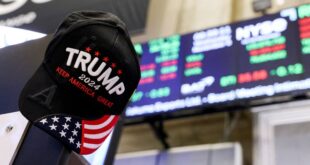The S&P 500 (SNPINDEX: ^GSPC) is the most widely followed stock market index in the U.S. and includes the 500 largest companies in the country. Because it contains a broad swath of American businesses, it’s also considered by many to be the best overall benchmark and the most reliable gauge of overall stock market performance.
The storied index has been squarely in rally mode since it bottomed in October 2022, driven higher by waning inflation, the advance of artificial intelligence (AI), and the Federal Reserve Bank’s long-awaited decision to begin its campaign of interest rate cuts. These factors have combined to create an environment that’s ripe for the stock market rally to continue.
The S&P 500 just delivered its best January-through-September performance since 1997 and has now entered the third year of its current bull market run, something that hasn’t happened since 2011. If history is any indicator, the current rally still has much further to go.

A bull can run a long way
Fresh off the worst bear market since 2009, investors are relishing the good times — and well they should. History shows that bull markets have more stamina and tend to last much longer than their bearish counterparts.
Since World War II, the average bull market has lasted roughly four and a half years, according to data compiled by Bespoke Investment Group. For context, that’s far longer than the average bear market, which lasts roughly one year.
That said, not all bull markets are created equal. For example, the bull market that started in 1987 ran for more than 12 years, while the bull market that began in 2009 ran for 11 years. On the other end of the spectrum, the bull market that began in 2001 lasted just three months.
The current rally just completed its second full year, so — if history holds true — this bull market still has further to run. Of the 13 bull markets that have occurred over the past 77 years, seven have lasted three years or more, so history is on the side of the bulls.
Then there’s the matter of returns. Bull markets have generated returns of 152%, on average, which bodes well for current investors. However, the market gains varied greatly, depending on the length of the rally. For example, the bull market that began in 1987 generated returns of 582%, while the one that began in 2009 returned 400%. However, the short-lived rally of 2001 — which lasted just three months — returned just 21%.
Generally speaking, the longer the bull market, the greater the potential returns. That holds true for the ongoing run as well. Looking back to October 2022 — the beginning of the current market rally — the S&P 500 has generated returns of 63%. If history holds true, the current bull market has much more to give.
Where do we go from here?
There are plenty of opinions about the market and where we go from here. Goldman Sachs Chief U.S. Equity Strategist, David Kostin, just boosted his 2024 year-end target for the S&P 500 to 6,000 while lifting his 2025 target to 6,300. This suggests that after notching 22% gains already this year, the index is poised to tack on an additional 3%. It also suggests that the S&P 500 will climb 5% in 2025.
While market prognosticators will provide their best guesses about what happens from here, the truth is no one knows for sure. If the economy keeps ticking along, and business and consumer spending hold up, the current bull market has a shot at joining some of the longer bull market runs in history.
However, things don’t always go as planned. Investors should be aware of the potential for a “black swan” event, a random and seemingly unpredictable happening that can have an enormous impact on the financial landscape. Think the 2008 financial crisis or the recent global pandemic. Many a bull market run has been derailed by a black swan.
Does that mean investors should hunker down and fear the worst? Far from it. Market legend Peter Lynch — one of the most successful investors of all time — said, “Far more money has been lost by investors in preparing for corrections, or anticipating corrections, than has been lost in the corrections themselves.” This knowledge should help investors be mentally prepared for events that couldn’t possibly be foreseen.
The biggest takeaway from this exercise is that time is the biggest advantage that investors have. As illustrated by the above chart, the stock market has generated robust returns over time despite market downturns. Buying quality stocks and holding them for the long term is the best strategy for thriving in a bull market. Furthermore, continuing to add to your portfolio at regular intervals — a process known as dollar-cost averaging — and keeping it up during both bull and bear markets helps develop the discipline needed to thrive no matter what the conditions.
The stock market has returned 10% annually, on average, over the past 50 years, which helps illustrate the benefits of investing for the long term.
Should you invest $1,000 in S&P 500 Index right now?
Before you buy stock in S&P 500 Index, consider this:
The Motley Fool Stock Advisor analyst team just identified what they believe are the 10 best stocks for investors to buy now… and S&P 500 Index wasn’t one of them. The 10 stocks that made the cut could produce monster returns in the coming years.
Consider when Nvidia made this list on April 15, 2005… if you invested $1,000 at the time of our recommendation, you’d have $845,679!*
Stock Advisor provides investors with an easy-to-follow blueprint for success, including guidance on building a portfolio, regular updates from analysts, and two new stock picks each month. The Stock Advisor service has more than quadrupled the return of S&P 500 since 2002*.
*Stock Advisor returns as of October 14, 2024
Danny Vena has no position in any of the stocks mentioned. The Motley Fool has positions in and recommends Goldman Sachs Group. The Motley Fool has a disclosure policy.
The S&P 500 Just Did This for the First Time in 13 Years. Here’s What History Says Happens Next. was originally published by The Motley Fool
Source link
 meganwoolsey Home
meganwoolsey Home


